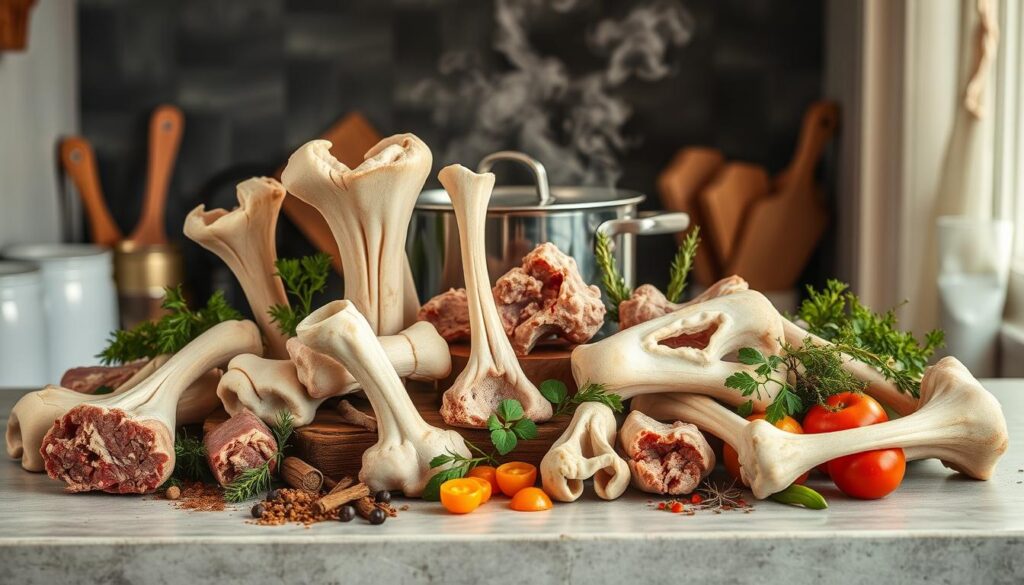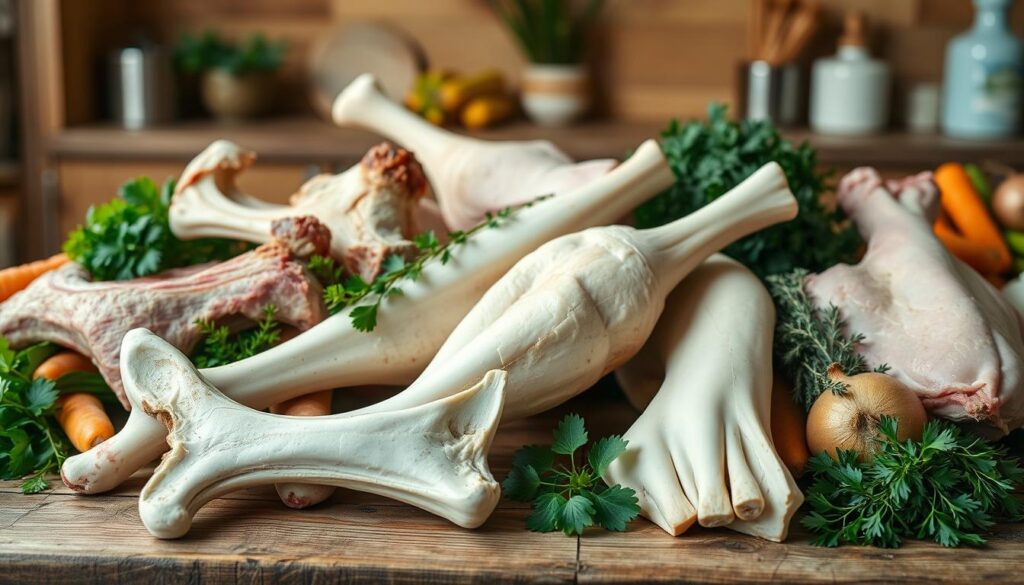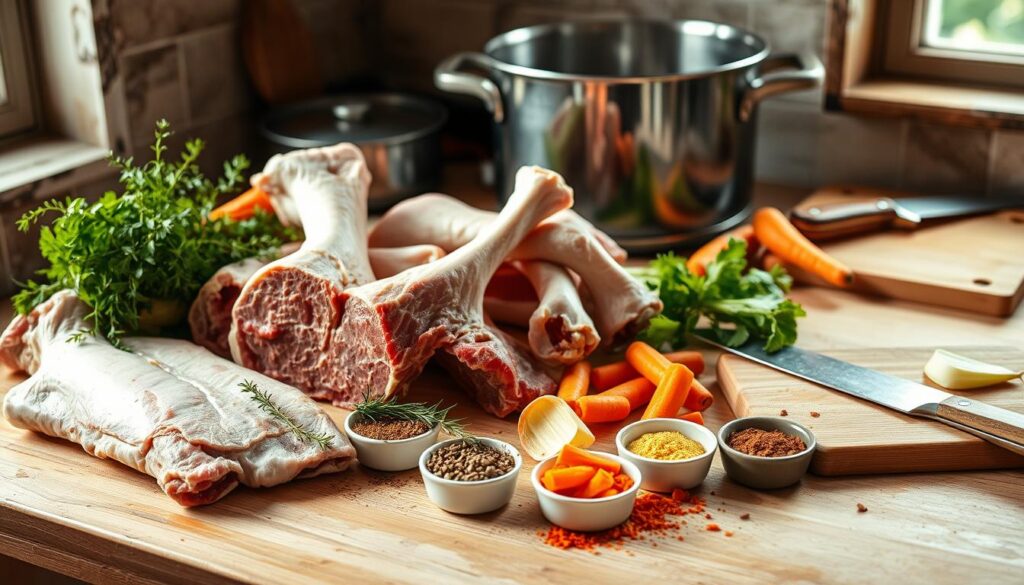A soup bone is a key ingredient in cooking. It makes soups and stews rich and savory. In slang, a soup bone is the bare bones of meats like beef, chicken, or pork. They are used to extract flavors.

Soup bones are vital in cooking. They are the base of a great stock or broth. Using them, you can make many dishes that are tasty and healthy.
- Understanding the concept of a soup bone is essential for creating delicious dishes
- A soup bone refers to the bare bones of meats used to extract flavors
- Soup bones are a key ingredient for creating rich and savory soups and stews
- The use of soup bones can elevate the flavor and nutritional value of your dishes
- Mastering the art of using soup bones can help you create a variety of mouth-watering dishes
Understanding Soup Bones and Their Culinary Value
Many people ask, can i eat soup bones? The answer is yes, but it’s important to know how to use them. Soup bones are not just leftover meat. They are full of nutrients and flavors. After cooking them for a long time, they become soft and safe to eat.
The question of can i eat soup bones? is common. Yes, you can, with some preparation. Different bones offer unique tastes and textures. Cooking with bones is also very nutritious, providing proteins, minerals, and collagen.
What Are Soup Bones?
Soup bones come from animals like beef, chicken. They can be raw or cooked. People use them to make broth or stock. The bones are simmered for a long time to get the flavors and nutrients.
Types of Bones Used in Cooking
There are many bones used in cooking, including:
- Marrow bones: These bones are rich in marrow and are often used to make broth or stock.
- Knuckle bones: These bones are high in collagen and are often used to make soups or stews.
- Neck bones: These bones are rich in meat and are often used to make soups or stews.
Nutritional Benefits of Cooking with Bones
Cooking with bones has many health benefits, including:
- Rich source of proteins
- High in minerals, such as calcium and phosphorus
- Rich in collagen, which can improve skin and joint health
Selecting the Best Soup Bones for Your Dishes
Choosing the right soup bones can really make your dish better. What is the best bone for soup depends on what you’re making. Beef bones are great for stews, while chicken bones work best for clear broths.
To pick the best bones, think about a few things:
- Type of dish: Different bones are better for different dishes.
- Personal preference: Think about the flavor and texture you want.
- Nutritional value: Bones vary in nutritional content.

- Beef bones: They’re full of collagen and flavor, perfect for stews and soups.
- Chicken bones: They’re lighter and versatile, great for clear broths and soups.
- Pork bones: They add a rich flavor and are often used in soups and stews.
| Type of Bone | Best For | Nutritional Value |
|---|---|---|
| Beef Bones | Hearty Stews | Rich in Collagen |
| Chicken Bones | Clear Broths | High in Protein |
| Pork Bones | Traditional Soups | Rich in Minerals |
Essential Preparation Techniques for Soup Bones
Understanding what bones are used in soup is key. Soup bones can come from different meats. The secret to a tasty soup is in how you prepare the bones.
Cleaning and trimming the bones is the first step. This removes any dirt or impurities. Roasting the bones next adds a lot of flavor. You can roast them in the oven or on the stovetop.
Blanching is also important. It helps get rid of any extra stuff from the bones. By doing these steps, you make a broth that’s rich and full of flavor.
Cleaning and Trimming
Cleaning and trimming the bones is the first step. Use water and vinegar to clean them. Then, cut off any extra meat or cartilage. This makes sure the bones are ready for roasting.
Roasting Methods
Roasting the bones makes them taste better. You can roast them in the oven or on the stovetop. The goal is to get them nice and brown. This brings out their deep, savory flavor.

Blanching Process
The blanching process is important. It removes impurities and makes the broth clear and flavorful. To blanch, just put the bones in boiling water for a few minutes. Then, rinse them with cold water.
| Preparation Technique | Description |
|---|---|
| Cleaning and Trimming | Remove impurities and excess meat or cartilage |
| Roasting | Enhance flavor by roasting bones in oven or on stovetop |
| Blanching | Remove impurities by submerging bones in boiling water |
Creating Rich Bone Broth: Step-by-Step Guide
Understanding what is a soup bone slang can help in cooking. You might ask, can i eat soup bones after cooking? Yes, they add nutrition and flavor to meals.
To make rich bone broth, start by picking the right bones. You can choose from beef, chicken, or pork bones. Then, simmer them to get all the flavors.
Here are the basic steps to follow:
- Preheat your oven to 400°F (200°C) and roast the bones for about 30 minutes to enhance the flavor.
- Then, place the bones in a large pot or stockpot and add enough water to cover them.
- Bring the water to a boil, then reduce the heat to a simmer and let it cook for at least 6 hours or overnight.
While simmering, add veggies and herbs for more taste. Carrots, celery, onions, bay leaves, and thyme are great choices. This way, you make a flavorful broth for many dishes.
By following these steps, you can make tasty and healthy bone broth. And yes, you can eat soup bones after cooking. Enjoy them as a snack or in your favorite recipes.
Traditional Soup Bone Recipes from Around the World
Different cultures have their own ways of using soup bones in cooking. You might be curious about what bones are used in soup and what’s the best bone for soup in traditional recipes. Exploring these questions can lead to discovering new flavors and cooking techniques.
In many Asian cultures, soups use bones like pork, chicken, and beef. The choice of bone depends on the flavor and texture you want. For instance, pork bones are key in tonkotsu ramen, a Japanese noodle soup. European bone broth traditions often use beef or veal bones, simmered for hours to make a rich stock.
Some well-known soup bone recipes include:
- Won ton soup, which uses pork bones for a light broth
- Bouillon, a French soup with beef and veal bones
- Chicken noodle soup, a classic American dish with chicken bones
Knowing which bones to use can help you make delicious, authentic dishes. Whether it’s a hearty stew or a light soup, the right bones can elevate your dish.

Trying different bones and recipes can broaden your cooking skills and appreciation for global cuisine. So, why not explore the world of soup bones? You might find your new favorite recipe.
| Recipe | Type of Bones | Flavor Profile |
|---|---|---|
| Won ton soup | Pork bones | Light and delicate |
| Bouillon | Beef and veal bones | Rich and flavorful |
| Chicken noodle soup | Chicken bones | Soothing and comforting |
Storage and Safety Tips for Soup Bones
When you handle soup bone, it’s key to know how to store and keep them safe. This prevents contamination and foodborne illnesses. You might ask what is a soup bone slang? But the main thing is to treat them carefully, like any other food. Here are some easy tips to keep your food safe and tasty:
First, store soup bones in a sealed container or bag to avoid mixing with other foods. You can keep them in the fridge for up to 3 days or freeze them for later. When freezing, remember to label the container with the date and what’s inside.
- Always wash your hands before and after touching soup bones
- Cook soup bones to at least 165°F (74°C) to kill bacteria
- Don’t leave cooked soup bones at room temperature for over 2 hours
By following these easy tips, you can make delicious and healthy meals with soup bones. This way, you can enjoy your meals while keeping foodborne illnesses at bay. Always remember to handle and store your soup bone ingredients properly.
Common Mistakes to Avoid When Cooking with Soup Bones
When cooking with soup bones, it’s key to know common mistakes. These mistakes can ruin the taste and safety of your dish. It’s important to understand which bones are safe for soup and how to use them.
One big mistake is not controlling the temperature right. This can make the bones too raw or too cooked. Also, adding the wrong seasonings can mess up the flavor of your soup. And, cooking the bones for the wrong amount of time can change their texture and taste.
To cook with soup bones well, you need to know the basics. This means knowing which bones are good for soup, like beef, chicken, or pork. You also need to know how long and at what temperature to cook them. By learning these things, you can make tasty and safe soups for your family.
| Type of Bone | Cooking Time | Temperature |
|---|---|---|
| Beef Bones | 1-2 hours | 180-200°F |
| Chicken Bones | 30-60 minutes | 160-180°F |
| Pork Bones | 1-2 hours | 180-200°F |
By following these tips and avoiding common mistakes, you can make delicious and safe soups. Always keep an eye on the temperature, seasonings, and cooking time. Whether you’re curious about eating soup bones or want to know which ones are best, knowing these details will make you a great cook.
Conclusion: Mastering the Art of Cooking with Soup Bones
As you finish your journey with soup bones, remember it’s a journey that never ends. Learning what best bone for soup and how to use them is key. It helps you make dishes that wow everyone.
Whether you’re making a rich bone broth or adding soup bones to your recipes, each step is a chance to get better. You’ll discover new flavors and improve your cooking skills.
Use what you’ve learned to try new things and grow your cooking skills. With patience, creativity, and a love for cooking with bones, you’ll open up a world of possibilities. Every dish will show the power of these versatile ingredients. Keep exploring and enjoying the journey with soup bones.
FAQ
What are soup bones?
Soup bones are the bare bones of meats, like beef, chicken, or pork. They’re used to make rich, flavorful stocks and broths for soups and stews.
Can I eat soup bones?
Yes, you can eat soup bones. But they must be cooked for a long time to make them soft and safe. They’re a good source of nutrients, including proteins, minerals, and collagen.
What is the best bone for soup?
The best bone for soup depends on the dish you’re making. Beef bones are great for hearty stews. Chicken bones are better for clear broths. Knowing the different bones and their uses is important for your cooking.
What bones are used in soup?
Many bones can be used in soups, like beef, chicken, and fish bones. The choice depends on the flavor you want and the soup or broth type.
What is a soup bone in slang?
In slang, a “soup bone” means the main ingredient for stock or broth. It’s the bones that bring out the rich flavors, making a delicious soup or stew.

